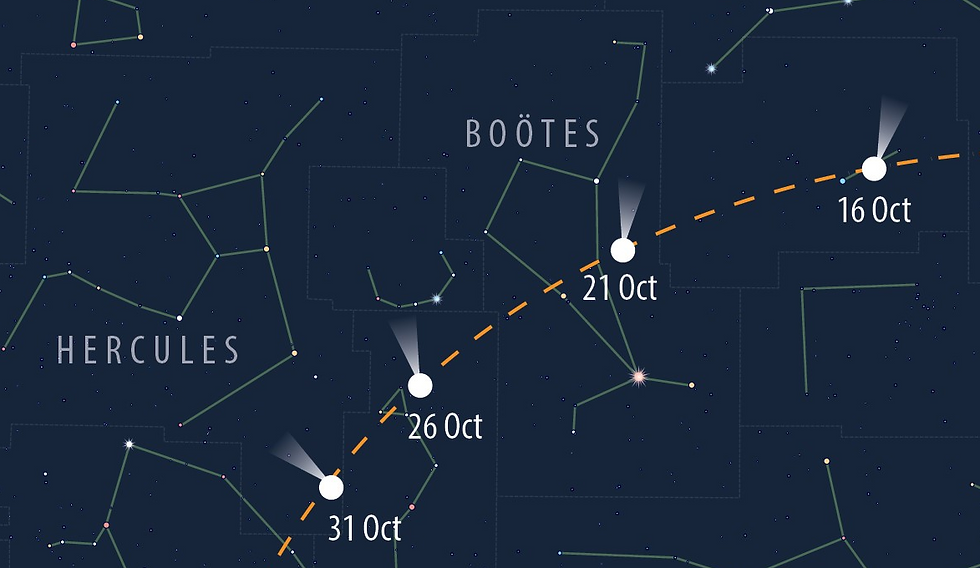A Rare Visitor in Our Skies: How to Spot Comet Lemmon Before It Vanishes
- UKSN

- Oct 22
- 3 min read
Every now and then, the night sky puts on a show that reminds us just how extraordinary our universe can be. This autumn, we’re being treated to one of those magical moments as Comet Lemmon (C/2025 A6) makes a rare appearance in the inner Solar System. It’s already bright enough to be seen with a decent pair of binoculars, and over the next week, it may even be visible to the naked eye. If you’ve ever wanted to witness a comet without needing a telescope, now’s your chance.

A Cosmic Traveller with a Dazzling Tail
Comet Lemmon was discovered back in January by astronomers at the Mount Lemmon Survey in Arizona. Most of the time, this icy traveller drifts silently through the distant outer reaches of our Solar System, far beyond Neptune. But as it swings closer to the Sun, it transforms from a frozen, quiet wanderer into a glowing celestial spectacle.
The Sun’s warmth causes the comet’s icy surface to sublimate, releasing gas and dust into space. Sunlight scatters off these tiny particles, creating the bright, glowing appearance we see from Earth. Solar wind pushes this material away from the comet’s core, forming the iconic sweeping tail that makes comets so mesmerising to watch. In recent weeks, Comet Lemmon’s tail and surrounding glowing cloud of gas (the coma) have become bright enough to stand out in the night sky.

Where and When to Look for Comet Lemmon
To catch a glimpse of Comet Lemmon, you don’t need a fancy telescope. A pair of good binoculars and a clear evening sky will do the job nicely.
Best viewing time: Around 8:00 pm (UK time)
Where to look: Low in the north-western sky
Constellation: Currently in Boötes, near the bright star Arcturus
Coming days: The comet will drift into the constellation Serpens
Find a dark spot away from street lights, give your eyes time to adjust, and scan the area near Arcturus. On a clear night, you should be able to spot a faint, fuzzy glow with a soft tail stretching out behind it. If skies remain clear, it could brighten even more, making it visible without any equipment.
Tips for the Best Viewing Experience
Get away from light pollution. Rural areas, campsites, or quiet fields offer the best conditions.
Use a star chart or stargazing app. These can help you pinpoint Boötes and Arcturus.
Be patient. It can take a few minutes for your eyes to fully adjust to the dark.
Dress warmly. Autumn evenings can be chilly, so wrap up before heading out.
Bring a tripod or rest your binoculars. Keeping your view steady will make spotting the comet easier.
For UKSN members who enjoy stargazing on camping trips or evening walks, this is a perfect opportunity to make the night sky part of your next outdoor adventure.
Why This Matters
Comets like Lemmon remind us how dynamic our Solar System really is. They’re ancient time capsules, carrying material left over from the formation of the planets billions of years ago. Seeing one with your own eyes is a direct connection to that distant past.
And unlike meteor showers or eclipses, bright comets are rare. Once Comet Lemmon continues its journey back into the cold depths of space, it won’t return for generations.
A Night to Remember
Whether you’re out on a wild camp, gathered around a fire with friends, or standing in your back garden, taking a moment to look up and spot Comet Lemmon can be truly magical. Bring a flask of something warm, wrap up in a blanket, and let the universe remind you just how big and beautiful it is.
If you capture any good photos or enjoy a sighting, share your experience in the UKSN community. Moments like these are even better when they’re shared.
✨ Tip: Keep checking the sky over the next few weeks. Conditions can change quickly, and if we’re lucky, Comet Lemmon will put on an unforgettable display.

.png)







Comments